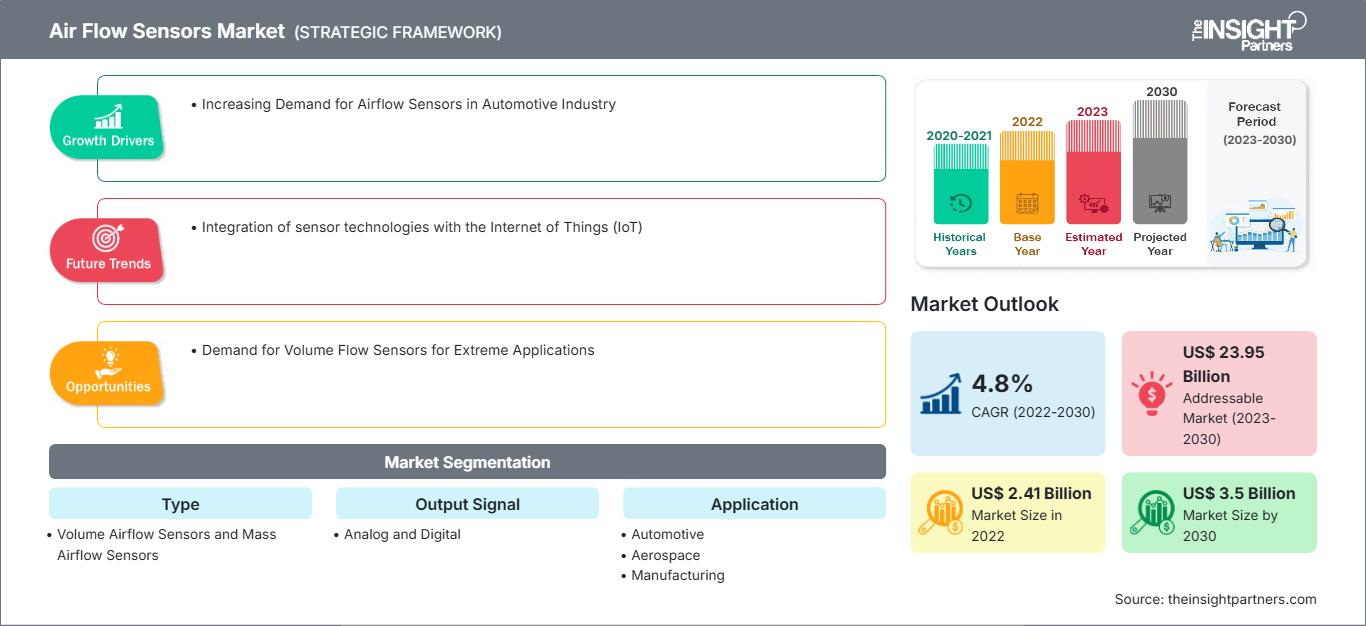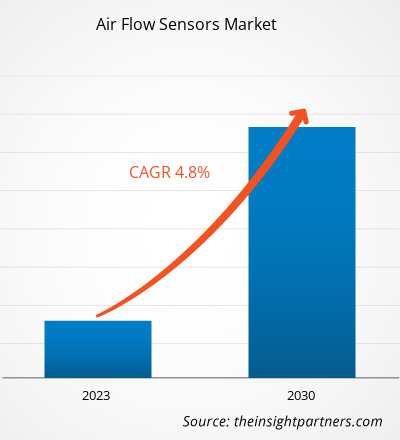Se prevé que el mercado de sensores de flujo de aire alcance los 3.500 millones de dólares estadounidenses en 2030, frente a los 2.410 millones de dólares estadounidenses en 2022. Se espera que el mercado registre una tasa de crecimiento anual compuesta (TCAC) del 4,8 % durante el período 2022-2030. La integración de las tecnologías de sensores con el Internet de las Cosas (IoT) probablemente seguirá siendo una tendencia clave en el mercado.
Análisis del mercado de sensores de flujo de aire
Los sistemas de climatización (HVAC) utilizan sensores de flujo de aire para garantizar un funcionamiento eficiente y reducir el consumo de energía. Estos sensores les permiten comparar la temperatura real del área con una temperatura objetivo y tomar las medidas necesarias. Los sistemas de control de climatización se emplean con frecuencia en diversos sectores, como la hostelería, las empresas, el comercio minorista y el sector residencial.
Panorama del mercado de sensores de flujo de aire
Los sensores de flujo de aire se utilizan para determinar el volumen o la masa del aire que fluye en un canal. Existen dos categorías: sensores de flujo de aire másico y sensores de flujo de aire volumétrico. Son fáciles de instalar y miden la presión total, la presión estática del flujo de aire y su velocidad. Los sensores de flujo de aire se utilizan en una amplia gama de sistemas industriales. En los vehículos, son cruciales para mantener una eficiencia de combustible y niveles de emisiones óptimos, y ayudan a la unidad de control del motor a ajustar la inyección de combustible para garantizar una combustión eficiente.
Obtendrá personalización gratuita de cualquier informe, incluyendo partes de este informe, análisis a nivel de país y paquetes de datos de Excel. Además, podrá aprovechar excelentes ofertas y descuentos para empresas emergentes y universidades.
Mercado de sensores de flujo de aire: Perspectivas estratégicas

- Obtenga las principales tendencias clave del mercado que se describen en este informe.Esta muestra GRATUITA incluirá análisis de datos, que abarcarán desde tendencias de mercado hasta estimaciones y pronósticos.
Factores impulsores y oportunidades del mercado de sensores de flujo de aire
El aumento de la demanda de sensores de flujo de aire en la industria automotriz favorecerá al mercado.
La industria automotriz es uno de los principales usuarios finales de sensores de flujo de aire. La creciente demanda de vehículos impulsa la necesidad de estos sensores, ya que se utilizan en motores y sistemas de escape para monitorizar y controlar el flujo de aire. La industria automotriz está experimentando un rápido crecimiento a nivel mundial. Asimismo, la penetración de los vehículos eléctricos está aumentando significativamente en todo el mundo. Según la Comisión Europea, la industria automotriz proporciona empleo directo e indirecto a 13,8 millones de europeos, lo que representa el 15,1 % del empleo total en Europa. De acuerdo con las estadísticas citadas por la Federación Europea de Transporte y Medio Ambiente, el gobierno del Reino Unido se comprometió a alcanzar el objetivo de cero emisiones netas para 2050 y propuso prohibir la venta de todos los vehículos contaminantes para 2035. Por lo tanto, las iniciativas de cero emisiones netas y la demanda de vehículos ecológicos por parte de los consumidores impulsan el mercado de sensores de flujo de aire.
Demanda de sensores de flujo volumétrico para aplicaciones extremas
Numerosas industrias, como la automotriz, la aeroespacial, la manufacturera, la energética y otras, requieren sensores de flujo volumétrico que soporten condiciones extremas. Esto impulsa a los actores del mercado a desarrollar sensores de flujo volumétrico para aplicaciones extremas. Por ejemplo, en septiembre de 2023, ENVEA presentó AirFlow P, una versión de alta temperatura de su sensor de flujo volumétrico para aplicaciones extremas. AirFlow P es un sensor para la medición de flujo volumétrico en entornos con polvo, apto para aplicaciones a temperaturas de hasta 800 °C.
Análisis de segmentación del informe de mercado de sensores de flujo de aire
Los segmentos clave que contribuyeron a la elaboración del análisis del mercado de sensores de flujo de aire son el tipo y la aplicación.
- Según su tipo, el mercado de sensores de flujo de aire se divide en sensores de flujo de aire volumétrico y sensores de flujo de aire másico. El segmento de flujo de aire volumétrico ostentó una mayor cuota de mercado en 2022.
- Según su aplicación, el mercado se divide en automoción, aeroespacial, fabricación, energía y servicios públicos, y otros. El segmento de automoción ostentó la mayor cuota de mercado en 2022.
Análisis de la cuota de mercado de los sensores de flujo de aire por geografía
El alcance geográfico del informe de mercado de sensores de flujo de aire se divide principalmente en cinco regiones: América del Norte, Asia Pacífico, Europa, Oriente Medio y África, y América del Sur y Central.
Países como Japón, India, China, Australia, Singapur, Taiwán e Indonesia cuentan con una amplia gama de industrias manufactureras, incluyendo electrónica, alimentos y bebidas, productos químicos, textiles, automóviles y atención médica. Además, iniciativas gubernamentales como "Made in China 2025" y "Made in India" impulsan estas industrias en diversos países de Asia Pacífico, lo que a su vez incrementa la demanda de sensores de flujo de aire. Asimismo, China posee una industria aeroespacial en rápido crecimiento. Un equipo de candidatos con sólidos conocimientos tecnológicos y jóvenes científicos en Beijing ha desempeñado un papel fundamental en misiones como las sondas lunares Chang'e y la exploración de Marte Tianwen. Estos avances en la industria aeroespacial impulsan el crecimiento del mercado de sensores de flujo de aire en China. Por otra parte, la creciente conciencia sobre la importancia de monitorear la calidad del aire refuerza la demanda de sistemas de climatización (HVAC) en Asia Pacífico, beneficiando así al mercado de sensores de flujo de aire en la región.
Perspectivas regionales del mercado de sensores de flujo de aire
Los analistas de The Insight Partners han explicado en detalle las tendencias regionales y los factores que influyen en el mercado de sensores de flujo de aire durante el período de previsión. Esta sección también analiza los segmentos del mercado de sensores de flujo de aire y su distribución geográfica en Norteamérica, Europa, Asia Pacífico, Oriente Medio y África, y Sudamérica y Centroamérica.
Alcance del informe de mercado de sensores de flujo de aire
| Atributo del informe | Detalles |
|---|---|
| Tamaño del mercado en 2022 | 2.410 millones de dólares estadounidenses |
| Tamaño del mercado para 2030 | 3.500 millones de dólares estadounidenses |
| Tasa de crecimiento anual compuesto global (2022 - 2030) | 4,8% |
| Datos históricos | 2020-2021 |
| período de previsión | 2023-2030 |
| Segmentos cubiertos | Por tipo
|
| Regiones y países cubiertos | América del norte
|
| Líderes del mercado y perfiles de empresas clave |
|
Densidad de los participantes en el mercado de sensores de flujo de aire: comprensión de su impacto en la dinámica empresarial
El mercado de sensores de flujo de aire está creciendo rápidamente, impulsado por la creciente demanda de los usuarios finales debido a factores como la evolución de las preferencias de los consumidores, los avances tecnológicos y una mayor conciencia de los beneficios del producto. A medida que aumenta la demanda, las empresas amplían su oferta, innovan para satisfacer las necesidades de los consumidores y aprovechan las nuevas tendencias, lo que impulsa aún más el crecimiento del mercado.

- Obtenga una visión general de los principales actores del mercado de sensores de flujo de aire.
Noticias y novedades recientes del mercado de sensores de flujo de aire
El mercado de sensores de flujo de aire se evalúa mediante la recopilación de datos cualitativos y cuantitativos tras una investigación primaria y secundaria, que incluye publicaciones corporativas importantes, datos de asociaciones y bases de datos. A continuación se enumeran algunos de los avances en el mercado de sensores de flujo de aire:
- ENVEA, proveedor líder de soluciones de monitorización ambiental, presenta la ampliación de su serie de sensores AirFlow P con la introducción de una versión para altas temperaturas, capaz de soportar hasta 800 °C. Esta incorporación amplía las capacidades del sensor AirFlow P, convirtiéndolo en la solución ideal para aplicaciones industriales aún más exigentes. (Fuente: ENVEA, sitio web de la empresa, septiembre de 2023)
- Posifa Technologies presentó la última versión de sus sensores de flujo de aire másico, que se utilizarán en el cuidado respiratorio y otras aplicaciones sanitarias y de instrumentación. Los sensores de las series PMF83000 y PMF86000 están diseñados para su uso en entornos exigentes con alta humedad y bajos niveles de gases corrosivos. (Fuente: Posifa Technologies, sitio web de la empresa, abril de 2021)
Cobertura y resultados del informe de mercado de sensores de flujo de aire
El informe “Tamaño y pronóstico del mercado de sensores de flujo de aire (2020-2030)” proporciona un análisis detallado del mercado que abarca las siguientes áreas:
- Tamaño y pronóstico del mercado de sensores de flujo de aire a nivel mundial, regional y nacional para todos los segmentos clave del mercado cubiertos por el alcance.
- Tendencias del mercado de sensores de flujo de aire, así como la dinámica del mercado, incluyendo factores impulsores, restricciones y oportunidades clave.
- Análisis detallado PEST/Cinco Fuerzas de Porter y SWOT
- Análisis del mercado de sensores de flujo de aire que abarca las principales tendencias del mercado, el marco global y regional, los principales actores, las regulaciones y los desarrollos recientes del mercado.
- Análisis del panorama industrial y la competencia, incluyendo la concentración del mercado, el análisis de mapas de calor, los principales actores y los desarrollos recientes del mercado de sensores de flujo de aire.
- Perfiles detallados de las empresas
- Análisis histórico (2 años), año base, pronóstico (7 años) con CAGR
- Análisis PEST y FODA
- Tamaño del mercado, valor/volumen: global, regional y nacional
- Industria y panorama competitivo
- Conjunto de datos de Excel
Informes recientes
Informes relacionados
Testimonios
Razón para comprar
- Toma de decisiones informada
- Comprensión de la dinámica del mercado
- Análisis competitivo
- Información sobre clientes
- Pronósticos del mercado
- Mitigación de riesgos
- Planificación estratégica
- Justificación de la inversión
- Identificación de mercados emergentes
- Mejora de las estrategias de marketing
- Impulso de la eficiencia operativa
- Alineación con las tendencias regulatorias




















 Obtenga una muestra gratuita para - Mercado de sensores de flujo de aire
Obtenga una muestra gratuita para - Mercado de sensores de flujo de aire